101 Leadership Actions
for
Effective
Presentations
OLLIE MALONE, PH.D.
HRD Press Amherst Massachusetts
2004 by Ollie Malone
All rights reserved. Any reproduction in any media of the materials that appear in this book without written permission from HRD Press is a violation of copyright law.
Published by:
HRD Press
22 Amherst Road
Amherst, MA 01002
1-800-822-2801 (U.S. and Canada)
413-253-3488
413-253-3490 (FAX)
www.hrdpress.com
ISBN 0-87425-803-0
Cover design by Perri Harper
Editorial services by Sally Farnham
Production services by PerfecType
T he projector is on. The room is full. Your introduction is about finished. Youre about to be called to the lectern. Now what?
Throughout the world, countless leaders are making presentations at any given day of the week.
Are you one of them?
This book is based on our experience of training thousands of individuals in giving effective presentations. These individuals have gone on to give presentations in academic environments, sales settings, political settings, religious environments, and face-to-face interactions.
According to numerous surveys, people dread giving presentations. In fact, the dreading is right up there with death and taxes.
We believe that presentation-dread is a curable disease and we have formulated this book as the medicine for that cure. Like all medicines, however, possession alone is not the solution. We recommend that you read it regularly and put the many ideas here to practice. Theyve already been tested with othersyou just need to pick the ones that will work for you. Break a leg!
Getting the Most Out
of This Book
T his book is organized in such a way that you need not read it from cover to cover. In fact, you might be a bit bored reading the entire book, and doing so will not necessarily provide you with the greatest benefit.
Our recommendation is this:
Use this book as a handbook by laying it side-by-side with the presentation you may be currently working on.
As you encounter a snag in your presentation efforts or simply want some new ideas, check the book.
After youve finished your presentation, review some of the suggestions in this book for moving beyond your initial organization into the refining and polishing phase of your presentation.
Get a copy of this book for those who work with you or those who may need some fresh suggestions for better impacting the audiences to whom they speak.
As you become more skillful in delivering presentations, use this book as a diary; jot down other suggestions in the margins of the book that you have found to be particularly helpful.
Your listeners wont know what hit them!
Start with a
Brain Transplant
M any people struggle with delivering effective presentations because their assumptions about presentations are faulty in nature. In the list below, check the box next to each statement that reflects your views about developing and delivering presentations.
 Giving presentations is a necessary evil.
Giving presentations is a necessary evil.
 I wouldnt deliver presentations if I didnt have to.
I wouldnt deliver presentations if I didnt have to.
 Some days Im better at presenting information than others.
Some days Im better at presenting information than others.
 I just dont have the gift of gab.
I just dont have the gift of gab.
 I just cant stand up and b___ s___ my way through minutes of worthless rhetoric. Im a just the facts kind of person.
I just cant stand up and b___ s___ my way through minutes of worthless rhetoric. Im a just the facts kind of person.
 Giving a presentation is an opportunity for me to impress people with what I know about a given topic.
Giving a presentation is an opportunity for me to impress people with what I know about a given topic.
 I believe I know a lot about this topic, and I am looking forward to an opportunity to share some of that knowledge with others.
I believe I know a lot about this topic, and I am looking forward to an opportunity to share some of that knowledge with others.
 I see myself becoming more effective at delivering presentations with every one that I do.
I see myself becoming more effective at delivering presentations with every one that I do.
If you checked any one of the first six boxes, it may be time for you to reconsider your beliefs about your presentations. As you do and begin to adopt some of the beliefs and assumptions reflected in the last two, youll enjoy presentations moreand youll likely find that youre better at them.
Give it a try!
Start to see
yourself
as the worlds
best presenter.
For many, the problem of effective presentations begins with a wrong self-image. They see themselves as clumsy, awkward, ill-at-ease, and thenvoilthey are. Start training your brain to see yourself not as a failure, but as a wildly successful person. Take note of how you look, how you feel, and what youre doing. Keep those images alive; they will serve you well as you move closer to the image.
Make a list of
those things you
would be doing.
There are certain things the greatest presenters do that the not-so-great presenters do not do. What do you see the top-shelf presenters do? How do they connect with you? How are their materials presented? How do they connect with other members of the audience? Learn from those who are really excellentand borrow their ideas liberally.
Make a list of
words and/or
terms that
describe
the new you.
Your list should not resemble War and Peace, but rather should be five to seven words/terms that capture either how you would like to feel on the inside or how you would like to be seen by others. Your list might include the following: Ease, engaging, knowledgeable, and worth listening to.
Find out what
others like
about your
presentations.
Sometimes were our own worst critics when it comes to presentations, yet others are able to see the strengths that often elude us. Get some feedback from others: What do they see you doing well? Write down their positive commentsand capitalize on them.
Continue to
refine your new
you list.
As you hear other words or terms that you would like to be applied to you, add them to the list formed in #3 above. Make this list a dynamic part of your preparation to present. Sharpen your descriptions, where necessary, and eliminate those that no longer work for you. Remember to keep your list at a manageable five to seven descriptors.
Ask others what
theyd like to
see you do
differently.
This might be difficult, but try not to think of it as a report card. This is a way for you to identify the outer limits of your presentation behavior. In other words, the lists you generated in #3 and #4 above represent the positive side of presentations for you. This is the negative side and forms a boundary for you. If you think your presentation is swaying toward this boundary, turn around!
Make yourself a
student of
effective
presentations.
Most of us are in situations where we frequently see and hear others make presentations. It might be something you observe on the television, a business or professional meeting you attend, or a religious service: Notice not only what is being said, but how it is being said. The how is another resource for you in your presentation-improvement strategy.
Ask others about
their perspectives
on effective
presentations.
By now, youve probably figured out that one of the most important things about presentations and their effectiveness is the mind-set that you bring to those presentations. If youve gotten that message, good job! Ask others what their perspectives are on effective presentations. Doing so should help you think about your presentations differently.
Next page
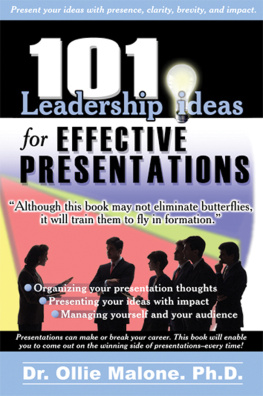


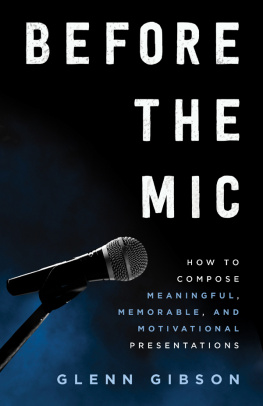

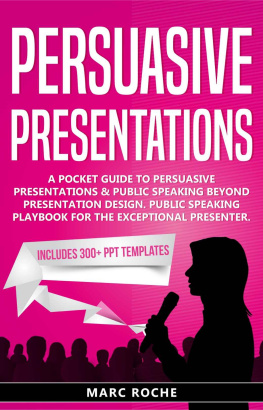
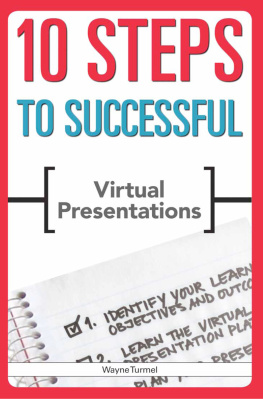
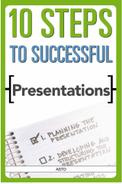
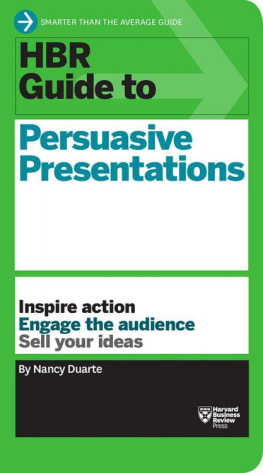
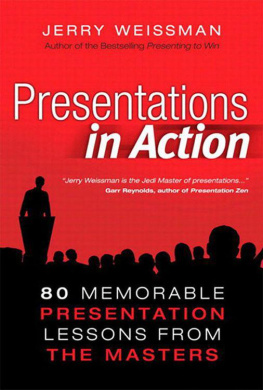
 Giving presentations is a necessary evil.
Giving presentations is a necessary evil.